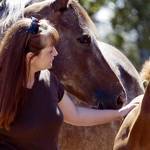Predicting Foaling in Mares: New Science

Many broodmare owners like to attend foal births to ensure the proceedings unfold smoothly and the foal stands, nurses, and consumes sufficient colostrum. Most owners, however, don’t have time to hover over late-pregnant mares 24/7, which makes any way to predict foaling highly coveted.
“Current methods used to predict foaling include analysis of mammary secretions collected prior to foaling, an array of commercial birth-monitoring systems, or the wait-and-see technique,” summarized Laura Petroski-Rose, B.V.M.S., a veterinarian for Kentucky Equine Research.
While horsemen often say that a mare’s gestational length is about 340 days, in truth, this number can vary remarkably depending on geography, breed, sex of foal, mare genetics, month of conception, among others.
To shorten the waiting game, a novel monitoring system was assessed to predict foaling*. This system was based on the hypothesis that increased restlessness in mares prior to the expulsive phase of parturition (the second stage, lasting about 15 minutes) could be detected by an accelerometer, which is affixed to a mare’s halter and programed to send out invisible wave signals at a rate of 600 signals/minute. Receivers placed on the walls of the stall received those signals, and any increase in signal rate due to increased movement of the mare—due to restlessness, for example—were detected.
Eight late-pregnant mares were recruited to test this novel birth-detection system. Differences in accelerations increased in the last 120 minutes until time of foaling, and were most pronounced during the 20- to 30-minute period prior to foaling.
“This pilot study shows promise for accelerometers as birth-detection units to ensure births are attended,” explained Petroski-Rose.
Providing excellent nutrition and preventive care, such as deworming and appropriate vaccinations, to the mare throughout gestation is another way to safeguard the health of foals. This includes managing body condition score so mares are not too thin or overweight at the time of foaling.
“Having mares in appropriate condition at the time of foaling not only paves the way for success during the current pregnancy but also prepares them for successful rebreeding, especially if owners attempt to breed on foal heat,” Petroski-Rose advised.
Need help tweaking your broodmare’s diet to achieve and maintain an appropriate body condition score? Consult an Kentucky Equine Research nutrition advisor today.
*Hartmann, C., L. Lidauer, J. Aurich, et al. Detection of the time of foaling by accelerometer technique in horses (Equus caballus)-a pilot study. Reproduction in Domestic Animals. In press.








